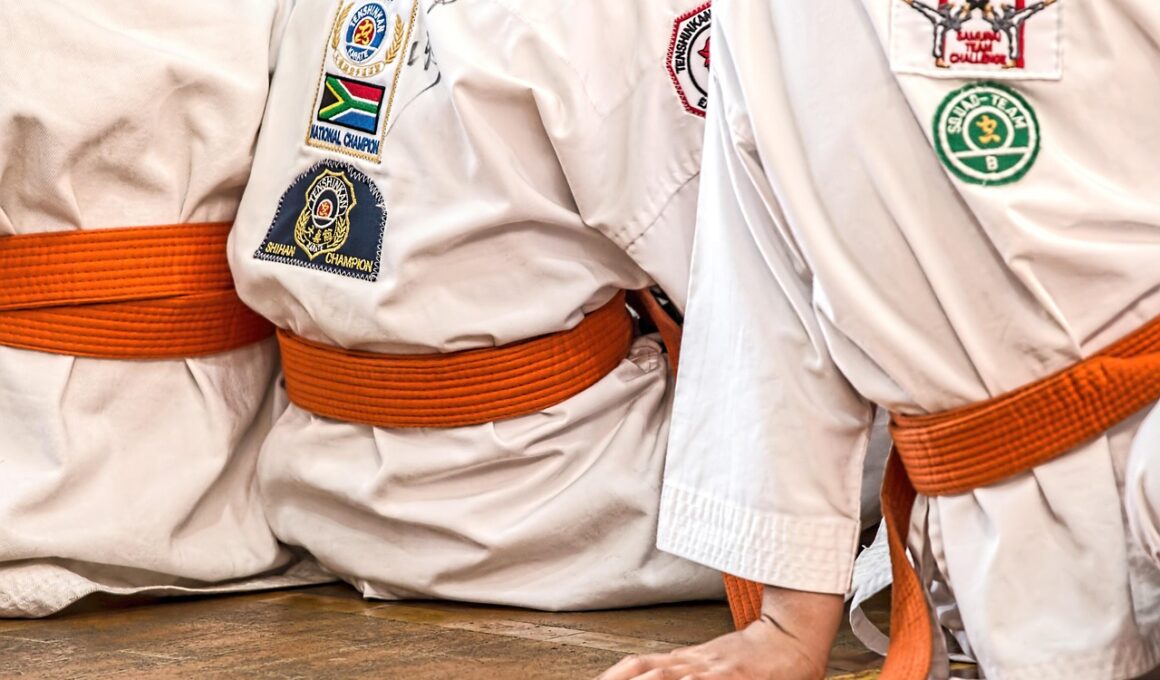Shorin Ryu Karate Drills for Improving Balance and Coordination
Practicing Shorin Ryu Karate allows martial artists to develop their balance and coordination through various drills. One highly beneficial drill involves the use of a balance beam. Standing on the beam, practitioners can perform various stances and transitions. The goal is to shift weight while maintaining control and stability. Integrating side kicks or front kicks while balancing can significantly enhance core strength and coordination. Another drill involves the use of slow-motion movements, where students practice techniques deliberately to ensure precision. This method enhances the practitioner’s understanding of balance as they must control their body during each movement. Shadow boxing is also vital in this aspect; moving through various techniques while focusing on center balance prepares a fighter for actual combat scenarios. Practitioners should consider recording their sessions to evaluate balance progress. By reviewing footage, one can identify areas requiring improvement. Utilizing both drills and self-analysis tools helps reinforce learning outcomes. The balance beam drill, in combination with slow-motion techniques and shadow boxing, effectively refines coordination skills, offering a robust path for martial arts enthusiasts seeking improvement and mastery.
A key element of Shorin Ryu Karate is the practice of focused footwork. Effective footwork drills can improve agility and positioning. One effective exercise entails performing stances, progressing through high knee lifts, and side steps. As practitioners become proficient in these moves, their balance improves naturally. Practitioners can create obstacle courses using cones or small barriers to navigate quickly and effectively. This adaptability is crucial for sparring situations where avoiding or countering attacks is vital. Including kicking techniques during footwork drills makes them more dynamic, challenging coordinative abilities further. Multi-tasking exercises, which incorporate both hand techniques and foot movements, are excellent for simultaneous improvement. For example, executing a strike while moving sideways helps in building synchronization. This than enhances the martial artist’s overall effectiveness during action sequences. Additionally, incorporating different speeds in practice can further challenge the practitioner’s ability to maintain balance. Focusing on movement patterns while combining them with strikes creates a real-world sparring scenario. Special attention should be placed on ensuring that footwork remains light. These footwork drills seamlessly integrate balance and coordination, paving a pathway for enhanced Shorin Ryu Karate performance.
Dynamic Movement Drills
Incorporating dynamic movement drills into Shorin Ryu Karate is vital for balance and coordination improvement. The implementation of complex sequences challenges muscle memory and adaptability. One drill involves performing a series of strikes that culminate in a series of katas executed swiftly. Each kata demand precision and balance, which students must continually refine through repetition. Combining various stances with striking techniques enhances the overall coordination while improving posture. Students may also benefit from partner drills that incorporate movement alongside timing and distance. Practicing blocks and counterattacks with a partner forces martial artists to adjust their balance based on opposing movements, which further hones their reflexes. Using visual cues or a target person for precision can provide additional motivation as practitioners strive to maintain control while executing techniques. Practicing drills with music can also enhance rhythm and flow. The tempo of the music encourages coordinated movement in both timing and speed. Breaking down complex sequences into manageable parts ensures gradual improvement. Incorporating these dynamic movement drills effectively develops balance and coordination for any Shorin Ryu Karate practitioner, ultimately enhancing overall performance.
Strength and balance go hand-in-hand, especially in martial arts like Shorin Ryu Karate. Practitioners should focus on strength-building routines that complement their training. Exercises involving core stabilization, such as planks or sit-ups, build the foundational muscles needed for balance. Additionally, practitioners can use resistance bands to enhance dynamic stability while practicing kicks or punches, thereby solidifying proper form. Incorporating functional strength training aids in fortifying the leg muscles, crucial for maintaining balance during movements. Shorin Ryu Karate techniques require strong legs to deliver powerful kicks while avoiding excessive upper body movement. A common drill involves practicing kicks while standing on one leg, emphasizing it. Switching legs throughout the drill challenges the body further, enhancing coordination as they must reacquaint their balance each time. To amplify these workouts, one can integrate plyometric exercises, which improve power and explosiveness. Jumping drills challenge tempo and coordination, creating efficient transition movements while dancing through combinations. Balance-enhancing drills such as using stability balls can also be effective. Balancing on a stability ball while executing various hand techniques bridges the gap between strength training and martial arts practice, improving the overall skillset.
Footwork and Body Positioning
Enhanced footwork techniques play a critical role in achieving balanced movements in Shorin Ryu Karate. Practitioners are tasked with refining their stances and transitions to ensure proper body alignment. A common starting point is practicing the natural stance, which emphasizes body awareness and stability. Practicing transitions between stances in a fluid and seamless manner develops the coordination necessary for effective karate movements. One effective drill involves stepping forward into a lunge, ensuring the back leg remains straight while delivering a punch. This incorporates proper positioning with hand techniques. Also practicing diagonal footwork enhances lateral movement, which is essential during sparring. As practitioners master basic movements, integrating creative footwork patterns, like mixing small jumps with kicks, can raise the drill’s complexity and fun factor. Additionally, emphasizing breathing techniques synchronizes breath with movement, promoting relaxation. Utilizing rhythm in drills, whether with music or counted beats, creates a pleasurable learning experience while honing vital skills. Students should encourage feedback from instructors and fellow practitioners to create a more focused training environment. Enhancing footwork not only promotes balance but also empowers practitioners in moments where precise movements matter.
Assessing balance and coordination improvement is essential for effective practice in Shorin Ryu Karate. Practitioners are encouraged to keep a journal detailing progress in stamina and skill. Regular self-assessment includes spontaneous testing of ability in various drills during training sessions. Using benchmarks or standards to gauge performance can reveal patterns and highlight areas needing attention. Practicing under different conditions – such as uneven surfaces or while closing eyes – can create real-time challenges that simulate real-life situations. This way, martial artists can identify specific strengths or weaknesses in skills. Additionally, after-action reviews can contribute valuable insights from peers or instructors, enhancing all learning aspects. To track developments, utilizing smartphones or cameras to record techniques assists in visual assessments. Reviewing footage allows for immediate feedback, spotting the balance shifts or movements enhancing skill sets. A key component of martial arts development involves lifelong learning and refining techniques. Hence, practitioners should establish specific short-term goals to maintain accountability. These parameters direct practice sessions towards desired outcomes, ensuring consistent improvement remains a priority. Documenting achievements alongside honing necessary skills significantly contributes to successful Shorin Ryu Karate training.
Conclusion and Future Practice
Balancing and coordination play crucial roles in mastering Shorin Ryu Karate effectively. Continuous practice of drills involving dynamic movements, focus, footwork, and strength will enhance the martial artist’s overall skillset. Practitioners must embrace the importance of structured drills while integrating them into regular training routines. Developing coordinated movements requires dedication and mindfulness in each practice session. Regular assessments of balance levels will lead to adjustments in techniques, fostering growth and improvement. Maintaining enthusiasm through engaging drills ensures that practice never feels monotonous. Collaborating with peers for feedback only further emboldens practitioners during their journeys. Thus, establishing future goals should be at the forefront of training plans, laying pathways for long-term skill acquisition. Future practice should incorporate innovative, enjoyable drills that challenge both balance and coordination, ensuring growth. Objective setting not only focuses on technical development but encourages resilience when faced with challenges. As each practitioner progresses, the art of Shorin Ryu Karate becomes a vibrant journey of continuous self-improvement. This exploration not only rewards martial artists with new skills but also benefits their overall confidence as they navigate life’s martial pathways.
By embracing balance and coordination in Shorin Ryu Karate, practitioners will find themselves on an exciting journey filled with physical growth, mental discipline, and unwavering resilience. Regular practice engaging these vital elements will create a lasting impact on martial artists’ living practices. Techniques learned in training can be applied outside karate; improved balance enhances day-to-day life, allowing for a more active lifestyle. With each successful balance drill, practitioners commit to overcome challenges while inspiring personal betterment. Thus, Shorin Ryu Karate’s rich culture enables individuals of all backgrounds to thrive and excel. Furthermore, exploring additional resources such as workshops, online tutorials, or camps can significantly enhance practice sessions. These resources can introduce fresh perspectives and innovative drills to keep training engaging. Building a supportive community of fellow practitioners strengthens accountability and encourages camaraderie. Ultimately, the balance and coordination exercises in Shorin Ryu Karate instill a sense of achievement while cultivating appreciation for the art. Overall, these attributes enrich every practitioner’s journey and empower them in all endeavors, both in martial arts and daily life.


